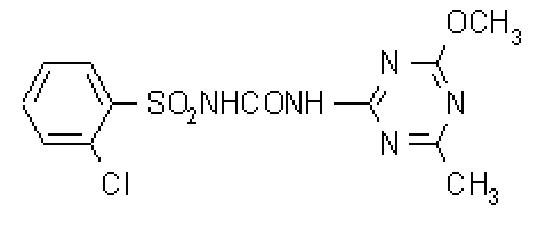Advertisements



Chlorsulfuron
| Price: | Contact for latest price |
|---|---|
| Minimum Order: | |
| Payment Terms: | N/A |
| Port of Export: |
Product Details
| Model No.: | Brand Name: |
|---|
| Certification: | |
|---|---|
| Specification: | N/A |
Packaging & Delivery
| Packaging: | |
|---|---|
| Delivery/Lead Time: | |
| Production Capacity: |
Product Description
Common name: chlorsulfuron
IUPAC name: 1-(2-chlorophenylsulfonyl)-3-(4-methoxy-6-methyl-1,3,5-triazin-2-yl)urea
Chemical Abstracts name: 2-chloro-N-[[(4-methoxy-6-methyl-1,3,5-triazin-2-yl)amino]carbonyl]benzenesulfonamide
CAS RN: [64902-72-3]
PHYSICAL CHEMISTRY
Mol. wt.: 357.8; M.f.: C12H12ClN5O4S; Form: White crystalline solid. M.p.: 174-178 ¯C. V.p.: 3x10-6 mPa (25 ºC). KOW: logP = -0.99 (pH 7). Henry: 3.0x10-9 Pa m3 mol-1 S.g./density: 1.48; Solubility: In water 587 ppm (pH 5), 3.18 g/100g (pH 7) (both 25 ºC). In dichloromethane 1.4, acetone 4, methanol 15, toluene 3, hexane <0.01 (all in g/l, 20 ºC). Stability: Stable to light when dry. Decomposes at 192 ºC. In aqueous solutions, DT50 4-8 w (pH 5.7-7.0, 20 ºC); significant degradation in 24-48 h (pH <5). Hydrolysis is also promoted by polar organic solvents such as methanol and acetone.
APPLICATIONS
Biochemistry: Branched chain amino acid synthesis (ALS or AHAS) inhibitor. Acts by inhibiting biosynthesis of the essential amino acids valine and isoleucine, hence stopping cell division and plant growth. Selectivity derives from rapid metabolism in the crop.
Mode of action: Selective systemic herbicide, absorbed by the foliage and roots, with rapid translocation acropetally and basipetally.
Uses: Control of most broad-leaved weeds and some annual grasses in wheat, barley, oats, rye, triticale, flax, and on non-crop land. Applied pre-emergence, early post-emergence, pre-plant, or early post-plant incorporated, at 9-25 g/ha.
Phytotoxicity: Phytotoxic to many broad-leaved crops, particularly sugar beet and brassicas.
Formulation types: WG.
MAMMALIAN TOXICOLOGY
Oral: Acute oral LD50 for male rats 5545, female rats 6293 mg/kg.
Skin and eye: Acute percutaneous LD50 for rabbits 2500 mg/kg. Mild eye irritant; non-irritating and non-sensitising to skin.
Inhalation: LC50 (4 h) for rats >5.9 mg/l air.
NOEL: (2 y) for rats 100, mice 500 mg/kg diet; (1 y) for dogs 2000 mg/kg diet.
ADI: 0.05 mg/kg.
Other: No oncogenic, mutagenic or teratogenic activity detected in standard tests. Acute i.p. LD50 for rats 1450 mg/kg.
Toxicity class: WHO (a.i.) III (Table 5); EPA (formulation) IV (75 WG)
EC hazard: N; R50, R53
ECOTOXICOLOGY
Birds: Acute oral LD50 for mallard ducks and bobwhite quail >5000 mg/kg. Dietary LC50 (8 d) for mallard ducks and bobwhite quail >5000 mg/kg diet.
Fish: LC50 (96 h) for rainbow trout >250, bluegill sunfish >300 mg/l. LC50 for fathead minnow >300, catfish >50, sheepshead minnow >980 mg/l.
Daphnia: LC50 (48 h) 370 mg/l.
Bees: LD50 (contact) >25 ug/bee.
Worms: LC50 >2000 mg/kg.
ENVIRONMENTAL FATE
Soil/Environment: In soil, deactivation is through hydrolysis followed by complete metabolism to low-molecular-weight compounds through normal soil microbial processes. Rate of hydrolysis is increased at lower pH. Average half-life under growing-season conditions is c. 4-6 weeks. Koc 40 (pH 7).

|
SUPPLIER PROFILE
|
|||
|---|---|---|---|
| Company: | Shanghai Skyblue Chemical Co., Ltd. | ||
| City/State | Shanghai, Shanghai | Country: |
China 
|
| Business Type: | Export - Manufacturer / Trading Company | Established: | 2010 |
| Member Since: | 2010 | Contact Person | Kevin Xu |
SUPPLIER PROFILE
City/State/Country -
Shanghai, Shanghai
China 

Business Type -
Export - Manufacturer / Trading Company
Established -
2010
Member Since -
2010
Contact Person -
Kevin Xu



